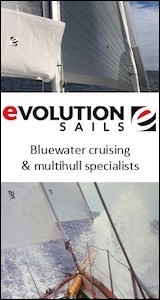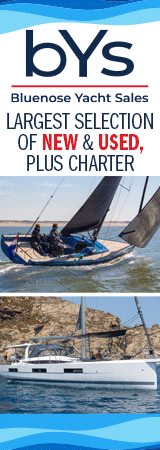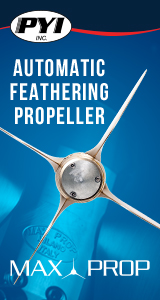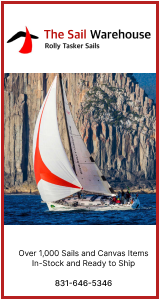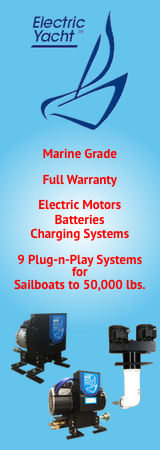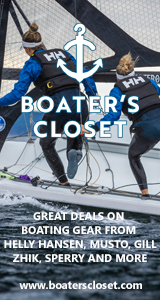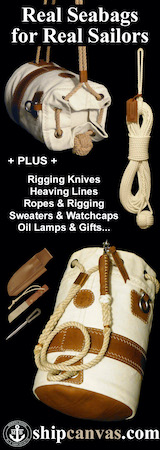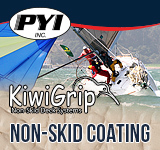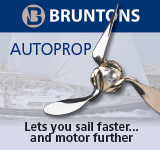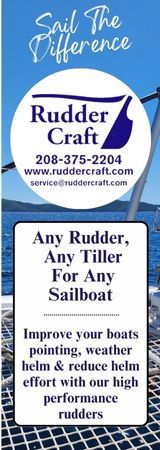Pearson Yachts
Founded by cousins, Clinton and Everett Pearson. It was the 28' TRITON sailing auxiliary that put the company 'on the map'. Before this they had been using the newfangled fiberglass construction materials to build dinghies and small power boats. At the request of Tom Potter, who worked for American Boat Building, the Pearsons set out to built a sailing auxiliary that would sell for under $10,000. Designer Carl Alberg was assigned the task of drawing the lines. After building the first boat, the Pearsons had to borrow money in order to have it transported to the 1959 New York Boat Show.
Before the show ended, they had deposits for 17 orders and the Pearsons took the company public that April.
Sales stayed strong enough for the company to purchase the old Herreshoff Yard as an additional production site. In addition, a number of new models were introduced, again, mostly designed by Carl Alberg and the company was building nearly one boat a day.
In order to finance further growth, the Pearsons tried to get approval for another stock offering but were not successful.
In 1961, Grumman Allied Industries bought a controlling interest in Pearson Yachts in order gain a stake in the developing fiberglass technology. Pearson was considered a leader in the field at the time. Under the Grumman umbrella the company experienced stability and steady growth for a number of years. During this period, new models continued to be introduced, most also designed by Alberg.
There was the ELECTRA, which had been added in 1960, and the ALBERG 35 introduced in 1961. Also by Alberg were that 26 foot ARIEL, and a 16' HAWK. Soon afterward came the INVICTA, a 38-footer designed by William Tripp Jr., the first production fiberglass boat to win the Newport-to-Bermuda Race. The lineup at this time also included a few medium sized powerboats.
In 1964, Grumman financed the construction of a 100,000-square-foot manufacturing plant in Portsmouth, R.I., and planned to move the company there the following year. At this time, the designer, William Shaw was hired as the Director of Design and Engineering.
At the Portsmouth factory business was booming for Pearson Yachts and Grumman combined the sailboat company with its subsidiary that made aluminum canoes and truck bodies.
But the Pearsons began to chafe at the Grumman corporate culture and they both decided to go their own separate ways. Clinton Pearson bought out Sailstar Boat Co.of West Warwick, R.I. and moved the assets to the factory in Bristol, RI. and created a new company called Bristol Yachts. Everett Pearson joined Neil Tillotson to form Tillotson-Pearson, Inc., (later TPI Composits) which became a major force in industrial uses of fiberglass-reinforced plastics and other, more exotic composites, with a product line including windmill blades, flag poles, subway cars, aquatic therapy pools, and J-Boats, among other sailboats and power boats.
William Shaw was named general manager of the Pearson Yacht Division. Under Shaw's leadership, Pearson Yachts continued it's rapid growth during the late 1960's and early 1970's. The product line continued to expand with new Shaw designed models up to 44 feet.
In 1980, Grumman expanded the Portsmouth plant to 240,000 square feet and the company built ever larger yachts like the Pearson 530 which was the largest the company ever built.
In March 1986, Grumman sold Pearson Yachts to a private investor group headed by Gordon Clayton.
Clayton had also purchased the tooling and rights to built the LASER, SUNFISH, and the entire line of O'Day Corp.
With the recession of 1990 the molds and trademarks were shuffled back and forth between a number of different entities. Grumman re-purchased all the assets and then promptly sold everything off in a bankruptcy sale.
PEARSON HID (1972-): PEA
CAL-PEARSON CORPORATION HID (1986-2003): KDG
Years in Business: 1958 - 1990
Sailboats Built By Pearson Yachts
(Dates indicate when boat was first built by any builder)
83 Sailboats / Per Page: 50 / Page: 1
| MODEL | LOA | FIRST BUILT | FAVORITE | COMPARE |
|---|---|---|---|---|
| 210 | 29.83 ft / 9.09 m | 1946 |
|
|
| ALBERG 35 | 34.75 ft / 10.59 m | 1961 |
|
|
| ARIEL 26 (PEARSON) | 25.58 ft / 7.80 m | 1962 |
|
|
| COASTER 30 (PEARSON) | 30.00 ft / 9.14 m | 1966 |
|
|
| COMMANDER 26 (PEARSON) | 26.00 ft / 7.92 m | 1964 |
|
|
| COUNTESS 44 (PEARSON) | 44.50 ft / 13.56 m | 1965 |
|
|
| ELECTRA (PEARSON) | 22.50 ft / 6.86 m | 1960 |
|
|
| ENSIGN (PEARSON) | 22.50 ft / 6.86 m | 1962 |
|
|
| FLYER (PEARSON) | 29.92 ft / 9.12 m | 1981 |
|
|
| GRUMMAN DINGHY | 8.52 ft / 2.60 m | 1959 |
|
|
| GRUMMAN FLYER | 16.16 ft / 4.93 m | 1968 |
|
|
| HAWK 16 (PEARSON) | 16.33 ft / 4.98 m | 1961 |
|
|
| INDEPENDENCE 20 | 20.50 ft / 6.25 m | 1999 |
|
|
| INVICTA (TRIPP) | 37.75 ft / 11.51 m | 1960 |
|
|
| INVICTA II (TRIPP) | 37.67 ft / 11.48 m | 1964 |
|
|
| LARK 24 (PEARSON) | 24.00 ft / 7.32 m | 1966 |
|
|
| PACKET (PEARSON) | 18.00 ft / 5.49 m | 1963 |
|
|
| PEARSON 10M | 33.04 ft / 10.07 m | 1973 |
|
|
| PEARSON 21 (TRITON 21) | 21.00 ft / 6.40 m | 1985 |
|
|
| PEARSON 22 | 22.25 ft / 6.78 m | 1968 |
|
|
| PEARSON 23 | 23.00 ft / 7.01 m | 1978 |
|
|
| PEARSON 23C | 23.00 ft / 7.01 m | 1983 |
|
|
| PEARSON 24 | 23.50 ft / 7.16 m | 1967 |
|
|
| PEARSON 25 | 25.00 ft / 7.62 m | 1986 |
|
|
| PEARSON 26 | 26.12 ft / 7.96 m | 1970 |
|
|
| PEARSON 26 (ONE-DESIGN) | 26.17 ft / 7.98 m | 1978 |
|
|
| PEARSON 26 WEEKENDER | 26.17 ft / 7.98 m | 1975 |
|
|
| PEARSON 27 | 26.92 ft / 8.21 m | 1986 |
|
|
| PEARSON 27 (TRITON 27) | 27.00 ft / 8.23 m | 1984 |
|
|
| PEARSON 28 (1975-80) | 28.00 ft / 8.53 m | 1975 |
|
|
| PEARSON 28 (1980-82) | 28.00 ft / 8.53 m | 1980 |
|
|
| PEARSON 28-2 | 28.46 ft / 8.67 m | 1985 |
|
|
| PEARSON 30 | 29.79 ft / 9.08 m | 1971 |
|
|
| PEARSON 300 | 30.25 ft / 9.22 m | 1969 |
|
|
| PEARSON 303 | 30.29 ft / 9.23 m | 1983 |
|
|
| PEARSON 31 | 31.00 ft / 9.45 m | 1977 |
|
|
| PEARSON 31-2 | 30.67 ft / 9.35 m | 1987 |
|
|
| PEARSON 32 | 31.75 ft / 9.68 m | 1979 |
|
|
| PEARSON 323 | 32.25 ft / 9.83 m | 1976 |
|
|
| PEARSON 33 | 32.92 ft / 10.03 m | 1969 |
|
|
| PEARSON 33-2 | 32.50 ft / 9.91 m | 1985 |
|
|
| PEARSON 34 | 33.79 ft / 10.30 m | 1983 |
|
|
| PEARSON 34-2 | 34.50 ft / 10.52 m | 1989 |
|
|
| PEARSON 35 | 35.00 ft / 10.67 m | 1968 |
|
|
| PEARSON 36 | 36.56 ft / 11.14 m | 1972 |
|
|
| PEARSON 36 CUTTER | 36.42 ft / 11.10 m | 1981 |
|
|
| PEARSON 36 PILOT HOUSE | 36.42 ft / 11.10 m | 1978 |
|
|
| PEARSON 36-2 | 36.50 ft / 11.13 m | 1985 |
|
|
| PEARSON 365 | 36.42 ft / 11.10 m | 1976 |
|
|
| PEARSON 365 KETCH | 36.42 ft / 11.10 m | 1976 |
|
